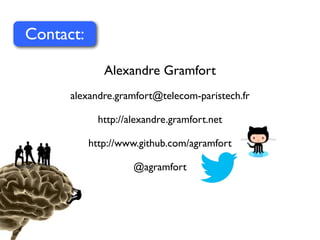Paris machine learning meetup 17 Sept. 2013
- 1. Alexandre Gramfort http://alexandre.gramfort.net http://scikit-learn.org “Lire dans les pensées avec Scikit-Learn” “Mind Reading with Scikit-Learn” Paris Machine Learning Meetup - Sept. 2013
- 2. Alexandre Gramfort Mind Reading with the Scikit-Learn Basics of Functional MRI (fMRI) 2 Oxy. Hb Deoxy. Hb Neurons 3D volumes (1 every 1 or 2s) High spatial resolution (vox ⋍ 2mm) Scanner Nuclear Magnetic Resonance
- 4. Alexandre Gramfort Mind Reading with the Scikit-Learn Learning from fMRI 4 Image, sound, task fMRI volumes Challenge: Learn and Predict from the fMRI data scanning Machine Learningstim Any variable: healthy?
- 5. Alexandre Gramfort Mind Reading with the Scikit-Learn Result from Miyawaki et al. Neuron 2008 5 http://www.youtube.com/watch?v=h1Gu1YSoDaY
- 6. Alexandre Gramfort Mind Reading with the Scikit-Learn Result from Miyawaki et al. Neuron 2008 6 • Some details about the data: • 2h of scanning • 1 image for 12s then 12s of rest • 800MB of raw data (200MB compressed) • 5,000 good voxels
- 7. Alexandre Gramfort Mind Reading with the Scikit-Learn Result from Nishimoto et al. 2011 7 http://www.youtube.com/watch?v=nsjDnYxJ0bo
- 8. Alexandre Gramfort Mind Reading with the Scikit-Learn Result from Nishimoto et al. 2011 8 • Some details about the data: • 30GB of stimuli (15 frames/s in .png for 3h) • about 4,000 volumes • about 10GB of raw data • 30,000 “good” voxels • > 3h in the scanner
- 9. Alexandre Gramfort Mind Reading with the Scikit-Learn Classification example with fMRI 9 !!"#$%&'()*+,-#./ 0123(%45678*###############################3(%45678*-#9:#;+*"#/:9:# <=+))8>8&+?85*#@#748*&87=() 67+&(#5>#?'(#A4+8*#>(+?%4()#BC%=?8D+48+?(E !"#$$%&'()*'+)#,-. FG4(H8&?#%*)((*#B?()?E#8C+I(@######54 F<5C7+4(#74(H8&?(H#=+A(=#J8?'#?4%(#?+4I(? K L8D(*#+#?4+8*8*I#H+?+#)(?#@#7+84) 5>#B>(+?%4()-#=+A(=E-#(/'",#?'(# &'+4+&?(48)?8>#(+&'#&+?(I54,#8*# ?'(#>(+?%4(#)7+&(@ F.*#?'8)#&+)(#74(H8&?(H#M#?4%(# FN(7(+?#>54#+==#)+C7=() FOD(4+I( !./ 0123(%45678*###############################3(%45678*-#9:#;+*"#/:9:# !"#$$%&'()*'+)#,-. FG4(H8&?#%*)((*#B?()?E#8C+I(@######54 F<5C7+4(#74(H8&?(H#=+A(=#J8?'#?4%(#?+4I(? F.*#?'8)#&+)(#74(H8&?(H#M#?4%(# FN(7(+?#>54#+==#)+C7=() FOD(4+I( The objective is to be able to predict given an fMRI volume !5678*###############################3(%45678*-#9:#;+*"#/:9:# !"#$$%&'()*'+)#,-. FG4(H8&?#%*)((*#B?()?E#8C+I(@######54 F<5C7+4(#74(H8&?(H#=+A(=#J8?'#?4%(#?+4I(? ?'(#>(+?%4(#)7+&(@ F.*#?'8)#&+)(#74(H8&?(H#M#?4%(# FN(7(+?#>54#+==#)+C7=() FOD(4+I( ie. objective: Predict giveny = { 1, 1} x 2 Rp y = { 1, 1} !+,-#./ 0123(%45678*###############################3(%45678*-#9:#;+*"#/:9:# !"#$$%&'()*'+)#,-. FG4(H8&?#%*)((*#B?()?E#8C+I(@######54 F<5C7+4(#74(H8&?(H#=+A(=#J8?'#?4%(#?+4I(? ?'(#>(+?%4(#)7+&(@ F.*#?'8)#&+)(#74(H8&?(H#M#?4%(# FN(7(+?#>54#+==#)+C7=() FOD(4+I( Patient Controlsvs. Faces Housesvs. ... ...vs. 1 -1vs.
- 10. Demo on Haxby et al. Science 2001 Challenge: Predict the object category viewed Sample stimuli: Face House Chair Shoe
- 11. Alexandre Gramfort Mind Reading with the Scikit-Learn Miyawaki et al. 2008 with Scikit-Learn 11 < 250 Lines of codes











